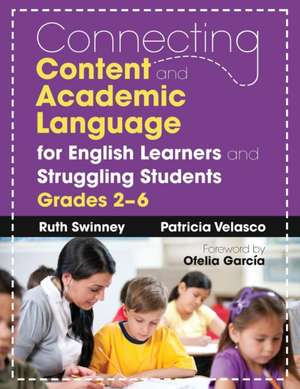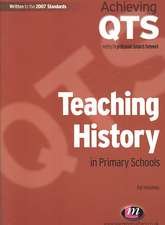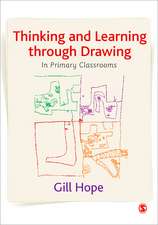Connecting Content and Academic Language for English Learners and Struggling Students, Grades 2–6
Autor Ruth Swinney, Patricia Velascoen Limba Engleză Paperback – 5 iul 2011
Preț: 292.04 lei
Nou
Puncte Express: 438
Preț estimativ în valută:
55.88€ • 58.49$ • 46.51£
55.88€ • 58.49$ • 46.51£
Carte disponibilă
Livrare economică 10-24 martie
Preluare comenzi: 021 569.72.76
Specificații
ISBN-13: 9781412988438
ISBN-10: 1412988438
Pagini: 200
Dimensiuni: 216 x 279 x 12 mm
Greutate: 0.56 kg
Ediția:1
Editura: SAGE Publications
Colecția Corwin
Locul publicării:Thousand Oaks, United States
ISBN-10: 1412988438
Pagini: 200
Dimensiuni: 216 x 279 x 12 mm
Greutate: 0.56 kg
Ediția:1
Editura: SAGE Publications
Colecția Corwin
Locul publicării:Thousand Oaks, United States
Recenzii
"When told not to simplify but rather to amplify a lesson for English learners, a teacher's first questions are: 'how and when?' In Swinney and Velasco's book, a Grade 2–6 teacher finds the answer to both questions and the tools to implement them. Congratulations! I do not know many books that can do that."
"The authors offer teachers a toolbox that explicitly illustrates scaffolding strategies to trigger background knowledge, link the building of academic language to the acquisition of new knowledge, and intertwine thinking skills throughout all experiences. Written in simple, user friendly language, this work will undoubtedly become a most useful tool for all teachers who seek to ensure academic success for emergent bilingual learners."
"Finally, teachers of English learners have the book they have needed for so long. Swinney and Velasco describe in a friendly and practical way the precise pedagogical sequence needed by Grade 2–6 school teachers in the education of ELs. In my personal experience the only way that English learners can develop their cognitive abilities in the second language is learning the second language within the content of the other curriculum matters."
"Many professors, staff developers and literacy coaches offer their conceptual knowledge but lack the wisdom of practice. Swinney & Velasco take the time to detail exactly the making of an ELL master teacher. Their teaching wisdom serves an often misunderstood student population—the struggling reader and writer. This book is a must-read to those practitioners in the field of second language special education."
"Swinney and Velasco provide an extraordinarily useful and comprehensive resource across content areas for the full spectrum of professionals working to improve the language and learning skills of students in Grades 2–6. Teacher educators as well as pre-service and beginning teachers will find a rich array of very concrete examples that detail effective instructional strategies, step-by-step action plans for achieving specific instructional objectives, and real-world vignettes of teachers achieving success with struggling students. This is an inspired and inspirational guide, well-informed by theory and research, and by the realities of actual classrooms. Both authors have extensive experience in classroom teaching, teacher supervision, program development and administration, and the writing of educational materials; their book distills the best of their combined 30 years of educational service."
"The authors' practical approaches for teaching content and language simultaneously are based on research and a deep knowledge of how classrooms operate. Every teacher working with language-diverse students will find much of value here.”
"The main contribution this book makes is to show teachers that they have other options rather than simplifying the material. Supremely practical, with careful and precise guidance, the book is for teachers in bilingual settings, in regular classrooms, and for ESL teachers. It can also be valuable in teacher training programs, which incorporate language objectives into all their planning."
"The authors offer teachers a toolbox that explicitly illustrates scaffolding strategies to trigger background knowledge, link the building of academic language to the acquisition of new knowledge, and intertwine thinking skills throughout all experiences. Written in simple, user friendly language, this work will undoubtedly become a most useful tool for all teachers who seek to ensure academic success for emergent bilingual learners."
"Finally, teachers of English learners have the book they have needed for so long. Swinney and Velasco describe in a friendly and practical way the precise pedagogical sequence needed by Grade 2–6 school teachers in the education of ELs. In my personal experience the only way that English learners can develop their cognitive abilities in the second language is learning the second language within the content of the other curriculum matters."
"Many professors, staff developers and literacy coaches offer their conceptual knowledge but lack the wisdom of practice. Swinney & Velasco take the time to detail exactly the making of an ELL master teacher. Their teaching wisdom serves an often misunderstood student population—the struggling reader and writer. This book is a must-read to those practitioners in the field of second language special education."
"Swinney and Velasco provide an extraordinarily useful and comprehensive resource across content areas for the full spectrum of professionals working to improve the language and learning skills of students in Grades 2–6. Teacher educators as well as pre-service and beginning teachers will find a rich array of very concrete examples that detail effective instructional strategies, step-by-step action plans for achieving specific instructional objectives, and real-world vignettes of teachers achieving success with struggling students. This is an inspired and inspirational guide, well-informed by theory and research, and by the realities of actual classrooms. Both authors have extensive experience in classroom teaching, teacher supervision, program development and administration, and the writing of educational materials; their book distills the best of their combined 30 years of educational service."
"The authors' practical approaches for teaching content and language simultaneously are based on research and a deep knowledge of how classrooms operate. Every teacher working with language-diverse students will find much of value here.”
"The main contribution this book makes is to show teachers that they have other options rather than simplifying the material. Supremely practical, with careful and precise guidance, the book is for teachers in bilingual settings, in regular classrooms, and for ESL teachers. It can also be valuable in teacher training programs, which incorporate language objectives into all their planning."
Cuprins
List of Illustrations
Foreword: Finding Cats and Dogs in the Zoo, by Ofelia Garcia
Acknowledgments
About the Authors
Part I: The Language Component: From Social to Academic Language
Introduction: Making Content Accessible to English Learners and Struggling Students
1. Building Language: How and Why
Background Knowledge and Its Relationship With Vocabulary
The Role that Background Knowledge Plays in Our Learning
Morphology and Syntax
Figurative Language
Conclusion
Questions for Reflection
2. From Social to Academic Language: a Curriculum of Talk
Developing Oral Language
The Social and Academic Language Continuum
What Is a Curriculum of Talk?
Goals of a Curriculum of Talk: The Role of Conversation
Different Types of Classroom Conversations That Support Listening and Speaking in the Classroom
Conclusion
Questions for Reflection
3. Structures of Balanced Literacy That Support English Language Learners and Struggling Students
What Is Balanced Literacy?
Literacy Practices That Support Language Growth
Adapting Balanced Literacy Components
Interactive Real Aloud
Shared Reading
Shared Writing
Conclusion
Questions for Reflection
Part II: The Lesson Component: Sample Units to Integrate Content and Language Goals
4. Language Arts Unit: Memoir (Grades 3-6)
Introduction
Section 1: The English Language Learner and Memoir
Breaking the Plan Into Doable Parts
Immersion in the Genre Through Read Aloud
Developing Knowledge About the Genre After Reading Many Memoirs
Section 2: Addressing Language Needs
Elements of Cohesion
Figurative Language
Conclusion
Teacher Self-Assessment for the Unit
5. Social Studies Unit: Colonial Times and the American Revolution (Grade 4)
The English Language Learner and the Social Studies Curriculum
Concepts and Teaching Tools
Breaking the Plan Into Doable Parts
Anchoring the Unit in a Read Aloud
Thinking Skills Used Throughout the Unit: Language Prompts
Vocabulary Development
Shared Reading: Working With Language Goals
Shared Writing
Conclusion
Teacher Self-Assessment for the Unit
6. Science Unit: Plant and Animal Adaptations (Grades 5-6)
The English Language Learner and Science
Planning the Unit
Breaking the Plan Into Doable Parts
Shared Reading
Developing Critical Thinking Skills Through Read Aloud
Experiment: Plant Adaptations
Individual Book Reports
Conclusion
Teacher Self-Assessment for the Unit
7. Thematic Unit: The Rainforest (Grades 2-3)
The English Language Learner and Thematic Units
Planning the Unit
Breaking the Plan Into Doable Parts
Social Studies and Math Concepts
Science
Language Arts
The Rainforest of the Amazon: The Play
Conclusion
Teacher Self-Assessment for the Unit
Conclusion
References
Index
Foreword: Finding Cats and Dogs in the Zoo, by Ofelia Garcia
Acknowledgments
About the Authors
Part I: The Language Component: From Social to Academic Language
Introduction: Making Content Accessible to English Learners and Struggling Students
1. Building Language: How and Why
Background Knowledge and Its Relationship With Vocabulary
The Role that Background Knowledge Plays in Our Learning
Morphology and Syntax
Figurative Language
Conclusion
Questions for Reflection
2. From Social to Academic Language: a Curriculum of Talk
Developing Oral Language
The Social and Academic Language Continuum
What Is a Curriculum of Talk?
Goals of a Curriculum of Talk: The Role of Conversation
Different Types of Classroom Conversations That Support Listening and Speaking in the Classroom
Conclusion
Questions for Reflection
3. Structures of Balanced Literacy That Support English Language Learners and Struggling Students
What Is Balanced Literacy?
Literacy Practices That Support Language Growth
Adapting Balanced Literacy Components
Interactive Real Aloud
Shared Reading
Shared Writing
Conclusion
Questions for Reflection
Part II: The Lesson Component: Sample Units to Integrate Content and Language Goals
4. Language Arts Unit: Memoir (Grades 3-6)
Introduction
Section 1: The English Language Learner and Memoir
Breaking the Plan Into Doable Parts
Immersion in the Genre Through Read Aloud
Developing Knowledge About the Genre After Reading Many Memoirs
Section 2: Addressing Language Needs
Elements of Cohesion
Figurative Language
Conclusion
Teacher Self-Assessment for the Unit
5. Social Studies Unit: Colonial Times and the American Revolution (Grade 4)
The English Language Learner and the Social Studies Curriculum
Concepts and Teaching Tools
Breaking the Plan Into Doable Parts
Anchoring the Unit in a Read Aloud
Thinking Skills Used Throughout the Unit: Language Prompts
Vocabulary Development
Shared Reading: Working With Language Goals
Shared Writing
Conclusion
Teacher Self-Assessment for the Unit
6. Science Unit: Plant and Animal Adaptations (Grades 5-6)
The English Language Learner and Science
Planning the Unit
Breaking the Plan Into Doable Parts
Shared Reading
Developing Critical Thinking Skills Through Read Aloud
Experiment: Plant Adaptations
Individual Book Reports
Conclusion
Teacher Self-Assessment for the Unit
7. Thematic Unit: The Rainforest (Grades 2-3)
The English Language Learner and Thematic Units
Planning the Unit
Breaking the Plan Into Doable Parts
Social Studies and Math Concepts
Science
Language Arts
The Rainforest of the Amazon: The Play
Conclusion
Teacher Self-Assessment for the Unit
Conclusion
References
Index
Descriere
This teacher-friendly guide introduces educators to basic linguistic features and language components as well as to strategies for moving students from social to academic language.













